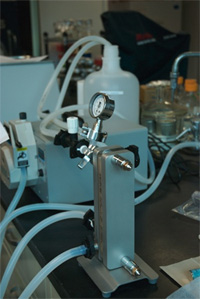New Enzymes for Biopulping
Who’s Involved?
 Research Introduction
Research Introduction
Wood contains cellulose, hemicellulose and lignin. Cellulose is used for making paper because it is a long fiber that can be easily dispersed in water, and easily forms entangled mats when dried. Hemicellulose is like cellulose, but it is made of much shorter fibers. Lignin is a large molecule that forms cross-links with hemicellulose and gives wood its hardness. Paper is made from cellulose, while biofuels can be made from both cellulose and hemicellulose. Breaking down the lignin makes it possible to extract cleaner cellulose and hemicellulose from a piece of wood. Traditionally, wood pulp was treated with sodium hydroxide and sodium sulfide to break down the lignin. Both of these chemicals are dangerous, and many of the byproducts of this pulp treatment are smelly, environmentally hazardous, toxic and/or carcinogenic. Wood processors are trying to find new ways to remove the lignin without using or making any dangerous chemicals. One problem in designing new processes for delignification is the stubborn chemical bonds between the hemicellulose and lignin components of wood. My laboratory has shown that there are microorganisms which can specifically break lignin-hemicellulose bonds without damaging cellulose or hemicellulose and without producing or requiring dangerous chemicals. The microorganisms do this by making a type of molecule called an enzyme. We are isolating these organisms and studying their enzymes. We are using this information to develop an enzyme-assisted pretreatment of wood pulp to improve the yield and quality of cellulose while reducing the use of harsh chemicals.
Research Details
Physical intertwining and chemical cross-links between the cellulose, lignin and hemicellulose of wood hinder the conversion of lignocellulose to products. The separation of the components of wood is an integral part of converting wood to fiber products, fuels and chemicals. In chemical pulping the largest energy and chemical costs are in preparing a cellulosic product with small amounts of lignin and hemicellulose. In the conversion of lignocellulose to chemicals and fuels the carbohydrate portions of wood (cellulose and hemicellulose) must be separated from the lignin and then can be converted into fermentable sugars. Our research addresses one of the basic problems of biorefining-how the components can be separated.
Our solution has been to bioprospect for enzymes that specifically cleave ether bonds between lignin and hemicellulose using a fluorogenic model compound based on hemicellulose. We have found several microorganisms that are potential sources of enzymes that can specifically break these bonds. Because these organisms are likely to produce other enzymes that break down hemicellulose and cellulose, we are currently engaged in isolating the enzyme activity from our microorganisms. The isolated enzyme will then be tested for its activity against lignin-hemicellulose complexes and its identity determined. The nature of the isolation method, along with its yield and the characteristics of the isolated enzyme will determine the feasibility of basing a wood fractionation process on the isolated enzyme.
An enzyme that cleaves the ether bonds of hemicellulose to lignin can have significant economic and environmental impact on the manufacturing of: bleached paper products, thermomechanical paper products such as newsprint, fermentable sugars for ethanol and chemical generation, and new products specifically derived from the polymeric forms of hemicellulose.
Related Links
